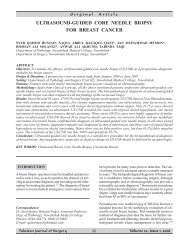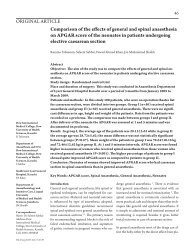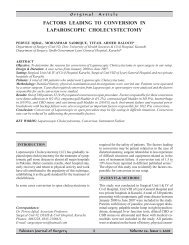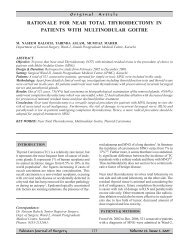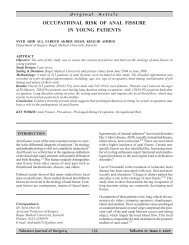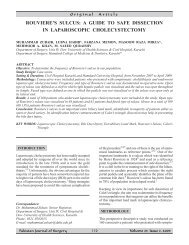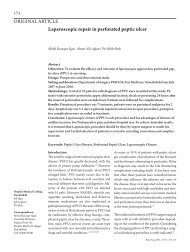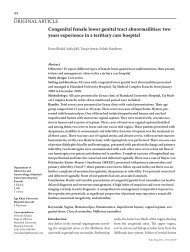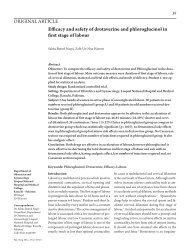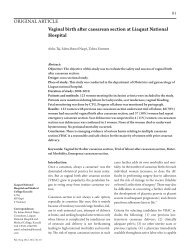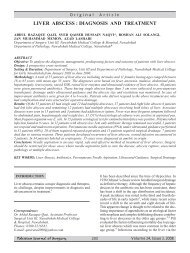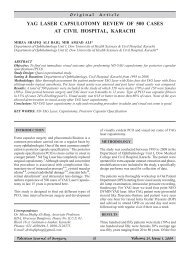Abruptio Placentae versus Placenta Previa as a risk factor for ...
Abruptio Placentae versus Placenta Previa as a risk factor for ...
Abruptio Placentae versus Placenta Previa as a risk factor for ...
- No tags were found...
You also want an ePaper? Increase the reach of your titles
YUMPU automatically turns print PDFs into web optimized ePapers that Google loves.
<strong>Abruptio</strong> <strong><strong>Placenta</strong>e</strong> <strong>versus</strong> <strong>Placenta</strong> <strong>Previa</strong> <strong>as</strong> a <strong>risk</strong> <strong>factor</strong> <strong>for</strong> Preterm LabourTuzovic Lea et al reported that 41% of womenwith placenta previa delivered prematurely. 6This finding is consistent with another studyconducted by Ananth CV et al. 3 Another studyagain conducted by Ananth CV and colleague in2001 w<strong>as</strong> not coinciding with above and the incidenceof preterm delivery w<strong>as</strong> 12% 20The placenta previa w<strong>as</strong> <strong>as</strong>sociated with 30.0%perinatal mortality rate and w<strong>as</strong> explained bygestational age at delivery. Ananth et al & Salihuobserved that the major causes of fetal death inplacenta previa were prematurity, severe haemorrhageand congenital abnormality. 21This study clearly demonsterated that womenolder than 30 years had higher <strong>risk</strong> of placentaprevia development. Frederiksen and his colleaguereported a similar observation, 22 althoughthe study of Abu-Heija et al, could notprove this <strong>as</strong>sociation. 8 The mechanism bywhich advanced maternal age impaires normalplacental development is not well understood.One of the possible explanations could be thatthe percentage of sclerotic changes on intramyometrialartries incre<strong>as</strong>es with incre<strong>as</strong>ing age,thereby reducing the blood supply to placenta.In the study of Abu Heija et al, the gravidity becameimportant after 5 or more previous pregnancies.Some earlier studies showed that paritybecame significant after 4 or more previouspregnancies. 8Women presented with vaginal spotting were atlower <strong>risk</strong> of being delivered prematurely, whencompared to women who had heavy bleeding.Lam CM et al reported similar results. 23Women with major placenta previa were foundto have higher number of previous c/section,which is in accordance with the study of Dolaet al, in 2003. 24 Study conducted by Ashraf Rand his colleague at Lahore General Hospital in2005 found 65% frequency. 25166It can be concluded that APH is an obstetricemergency <strong>as</strong>sociated with maternal and fetalmorbidity and mortality. Prematurity is thesingle most common re<strong>as</strong>on <strong>for</strong> neonatal mortality.The fetal survival is much lower in developingcountries than in developed world due tothe lack of properly equipped neonatal intensivecare facilities. The blood transfusion services,which are mainly available at tertiary care centresare unable to meet the demand of m<strong>as</strong>sivetransfusion which is required in APH. The etiologyof abruption may remain unknown so it willremain unavoidable cause of poor fetomaternaloutcome. More research is needed to explorethe insight of abruption to achieve a better outcome.The majority of patients of perinatal mortalitypresented with intrauterine death so that anymanagement protocol directed at abruptionplacenta and its consequences is of little help inpreventing perinatal mortality.Any patient who is at <strong>risk</strong> of abruption placentaand h<strong>as</strong> vaginal bleeding during the l<strong>as</strong>t trimesterof pregnancy should be hospitalized until thedelivery and blood transfusion. Obstetric outcome<strong>for</strong> women with the history of abruptionplacenta can be improved if good antenatal careis provided at a center with the expertise to identifythe <strong>risk</strong> <strong>factor</strong>s and to intervene timely.Women with <strong>risk</strong> <strong>factor</strong>s should be carefullyevaluated during pregnancy <strong>for</strong> detection of placentaprevia. The condition can be diagnosed onultr<strong>as</strong>onography. Early detection should encouragea careful and exact evaluation with timelydelivery in order to prevent or reduce the occurrenceof maternal and perinatal complications<strong>as</strong>sociated with placenta previa. The results ofstudy indicate that knowledge about the obstetric<strong>factor</strong>s predisposing the women <strong>for</strong> placentaprevia development is important <strong>for</strong> choosingadequate preventive me<strong>as</strong>ures <strong>for</strong> these women.Awareness of clinical <strong>risk</strong> <strong>factor</strong>s can aid in carefulpreoperative preparation and in counselingwomen with placenta previa regarding the likelihoodof encountering placenta accreta.Advanced maternal age, a <strong>risk</strong> <strong>factor</strong> <strong>for</strong> placentaprevia is important <strong>for</strong> women who contemplatedelayed child bearing and <strong>for</strong> clinicians whoprovide antenatal care and counseling to them.Pak J Surg. 2010; 26(2):163-168



